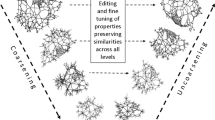Abstract
Connected planar graphs are of interest to a variety of scholars. Being able to simulate a database of such graphs with selected properties would support specific types of inference for spatial analysis and other network-based disciplines. This paper presents a simple, efficient, and flexible connected planar graph generator for this purpose. It also summarizes a comparison between an empirical set of specimen graphs and their simulated counterpart set, and establishes evidence for positing a conjecture about the principal eigenvalue of connected planar graphs. Finally, it summarizes a probability assessment of the algorithm’s outcomes as well as a comparison between the new algorithm and selected existing planar graph generators.







Similar content being viewed by others
Notes
This upper bound on n is a restriction set by the Fortran compiler used. It can be relaxed by changing the computer software for implementation (see supplementary material for the Fortran code).
References
Bodirsky M, Gröpl C, Kang M (2007) Generating labeled planar graphs uniformly at random. Theor Comput Sci 379:377–386
S. Meinert and D. Wagner, (2011) An experimental study on generating planar graphs, Karlsruhe Reports in Informatics,13, Karlsruhe Institute of Technology, Faculty of Informatics Karlsruhe, Germany, 2011
Osthus D, Prömel H, Taraz A (2003) On random planar graphs, the number of planar graphs and their triangulations. Journal of Combinatorial Theory, Series B 88:119–134
Bonichon N, Gavoille C, Hanusse N, Poulalhon D, Schaeffer G (2006) Planar graphs, via well-orderly maps and trees. Graphs and Combinatorics 22:185–202
O. Giménez and M. Noy. “The number of planar graphs and properties of random planar graphs,” Proceedings of the 2005 International Conference on Analysis of Algorithms C. Saunders, M. Grobelnik, S. Gunn, and J. Shawe-Taylor (editors), Springer-Verlag, Berlin (2005) pp. 147–156
R. Read and R. Wilson (2005) An Atlas of Graphs, Clarendon press, Gloucestershire, England
Geographical Analysis, (2011) Issue 4, 43, 345–435
Fortin M-J, James P, MacKenzie A, Melles S, Rayfield B (2012) Spatial statistics, spatial regression, and graph theory in economy. Spat Stat 1:100–109
Boots B, Royal G (1991) A conjecture on the maximum value of the principal eigenvalue of a planar graph. Geogr Anal 23:276–282
M. Tait and J. Tobin, (2016) Three conjectures in extremal spectral graph theory, arXiv:1606.01916v1 [math.CO], last accessed on 15 December 2016
Páez A, Scott D, Volz E (2008) Weight matrices for social influence analysis: an investigation of measurement errors and their effect on model identification and estimation quality. Soc Networks 30:300–317
Griffith D (2017) Some robust assessments of Moran eigenvector spatial filtering. Spatial Statistics 22:155–179
Masucci A, Smith D, Crooks A, Batty M (2009) Random planar graphs and the London street network. The European Physical Journal B 71:259–271
Ermagun A, Levinson D (2018) An introduction to the network weight matrix. Geogr Anal 50:76–96
D. Bauman, T. Drouet, M-J Fortin and S. Dray, (2018) Optimizing the choice of a spatial weighting matrix in eigenvector-based methods. Ecology, available at https://doi.org/10.1002/ecy.2469 (last accessed on 18 August 2018)
S. Arlinghaus, W. Arlinghaus, and F. Harary. (2002) Graph Theory and Geography: An Interactive View, Wiley, New York
G. Brinkmann, (n.d.) fullgen Manual, https://users.cecs.anu.edu.au/~bdm/plantri/fullgen-guide.txt, last accessed on 22 February 2017
E. Allender and M. Mahajan, The complexity of planarity testing. Inf Comput 189 (2004), 117–134
F. Harary and E. Palmer. 1973. Graphical enumeration. NY: Academic Press
Griffith D, Sone A (1995) Trade-offs associated with normalizing constant computational simplifications for estimating spatial statistical models. J Stat Comput Simul 51:165–183
Griffith D (2000) Eigenfunction properties and approximations of selected incidence matrices employed in spatial analyses. Linear Algebra Appl 321:95–112
Wilf H (1967) The eigenvalues of a graph and its chromatic number. J Lond Math Soc 42:330–332
Hoffman A (1970) “On eigenvalues and colorings of graphs,” Graph Theory and Its Applications H. Bernard (editor). Academic Press, New York, pp 79–92
G. Brinkmann and B. McKay, (2011) Guide for Using plantri (version 4.5), http://users.cecs.anu.edu.au/~bdm/plantri/plantri-guide.txt, last accessed on 22 February 2017
G. Brinkmann and B. McKay, (2012) Guide for Using buckygen (version 1.0), http://caagt.ugent.be/buckygen/buckygen-guide.txt, last accessed on 22 February 2017
Anderson T (1963) Asymptotic theory for principal components analysis. Ann Math Stat 34:122–148
Johnstone I (2001) On the distribution of the largest eigenvalue in principal components analysis. Ann Stat 29:295–327
Acknowledgments
Dr. Daniel A. Griffith is an Ashbel Smith Professor of Geospatial Information Sciences.
Author information
Authors and Affiliations
Corresponding author
Additional information
Publisher’s Note
Springer Nature remains neutral with regard to jurisdictional claims in published maps and institutional affiliations.
Publisher’s Note
Springer Nature remains neutral with regard to jurisdictional claims in published maps and institutional affiliations.
Electronic supplementary material
ESM 1
(TXT 13 kb)
Rights and permissions
About this article
Cite this article
Griffith, D.A. Generating random connected planar graphs. Geoinformatica 22, 767–782 (2018). https://doi.org/10.1007/s10707-018-0328-3
Received:
Revised:
Accepted:
Published:
Issue Date:
DOI: https://doi.org/10.1007/s10707-018-0328-3




